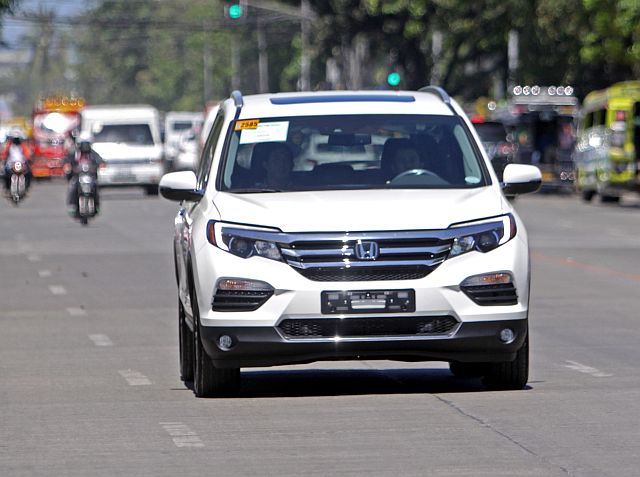
All-new Honda Pilot midsize crossover SUV(CDN PHOTO/LITO TECSON)
Honda Cars Cebu Inc. (HCCI) has brought to the Queen City of the South the all-new Honda Pilot midsize crossover SUV.
The third-generation Pilot is one of the most anticipated vehicles of Honda Cars this year and the first unit in Cebu recently touched down in HCCI’s showroom at the North Reclamation Area in Cebu City.
The elegant White Diamond Pearl-colored Pilot will be showcased to the public during the BPI Auto Madness event at the Ayala Center Cebu from this Friday to Sunday (March 11 to 13).
This version of the Pilot looks way better, has more features and greater capability than the model it replaces.
We did a test on the previous generation three years ago and also got to try briefly the all-new model. The most obvious improvement is the Pilot’s more elegant looks.
The Pilot’s 3.5-L V6 Earth Dreams engine (above) produces 280 horsepower and 355 Newton meters of torque. (CDN PHOTO/LITO TECSON)
In the second generation, styling wasn’t really the Pilot’s strongest point as it featured boxy detailing that didn’t really quite impress. Its strengths, aside from the branding, were its flawless suspension system; strong and efficient engine; convenient high-tech features; and comfortable plush interior.
The third generation has retained all of its predecessor’s strengths but with a vastly improved exterior styling and safety to create one heck of a SUV.
The all-new Pilot looks like a larger CR-V, Honda’s bet in the compact SUV segment, but with more glaring differences, such as its LED projector headlamps, daytime running lights and the seamless configuration of its LED taillights.
The body is now sleeker with more curves, a perfect match to the standard 18-inch alloy wheels on all corners. Although it is sexier, it is also quite long and wide as it measures 4,940 millimeters long and 1,996 mm wide.
Safety is also where the new Pilot has improved on as it now shares the same sensing technology with the celebrated Legend luxury sedan. These include adaptive cruise control, collision mitigating braking, lane keeping assist, forward collision warning, and lane departure warning. There are also the usual safety features such as ABS brakes, hill-start assist, vehicle stability assist, blind-spot monitor, and cross-traffic monitor.
Aside from ensuring passenger safety, Honda also saw to it that all eight passengers inside the Pilot are comfortable. This is the same quality that made the previous generation successful.
Aside from the spacious interior, the driver has the privilege of having a 10-way power seat with memory features. The front passenger also has a four-way power seat.
An innovative addition is its Touch 2nd Row Walk-in seat feature, wherein the second-row seat slides and tilts at one touch of a button for easier third-row passenger entry and exit.
The cabin is kept cool by a triple-zone climate control system with rear temperature control and rear door sunshades. Majority of the interior surfaces are wrapped in black leather and soft-touch plastics.
For audio and entertainment, Honda’s latest thinking for advanced technology is incorporated in its 8-inch Touchscreen Display Audio interface powered by a new Android-based operating system and more powerful processor.
Advanced features, such as Bluetooth, HDMI, USB Connectivity and 7 Speakers also fully extend to the frontline quality of the cockpit’s numerous functions. For the rear passengers, there is a 9-inch Entertainment System with DVD and HDMI capability available for in-transit entertainment needs.
The Pilot, meanwhile, is powered by Honda’s latest version of a 3.5-L V6 Earth Dreams engine that is neatly tucked into the vehicle’s front end. It is mated to a six-speed automatic transmission.
The direct injection and variable valve timing engine produces 280 horsepower (30 more horses compared to the second generation) and 355 Newton meters of torque.
Just like in the previous Honda Pilot engine, it uses a variable cylinder management to save on fuel. In this system, three cylinders are used during light loads while all six functions come into play when needed.
The Pilot also banks on an Intelligent Variable Torque Management to distribute power and torque to all four wheels.
Speaking of all-wheel drives, the Pilot has four modes to select from—normal, snow, mud and sand—which may be useful considering our unpredictable roads. The MacPherson struts up front and a multilink setup suspension at the rear also help keep the Pilot drive smoothly on any type of terrain.
So with all these great features, one may think this vehicle must be really expensive. Well, it is more expensive than the previous model, but even if it does have a higher price tag, we still think it is a great buy for those who are shopping for a midsize SUV.